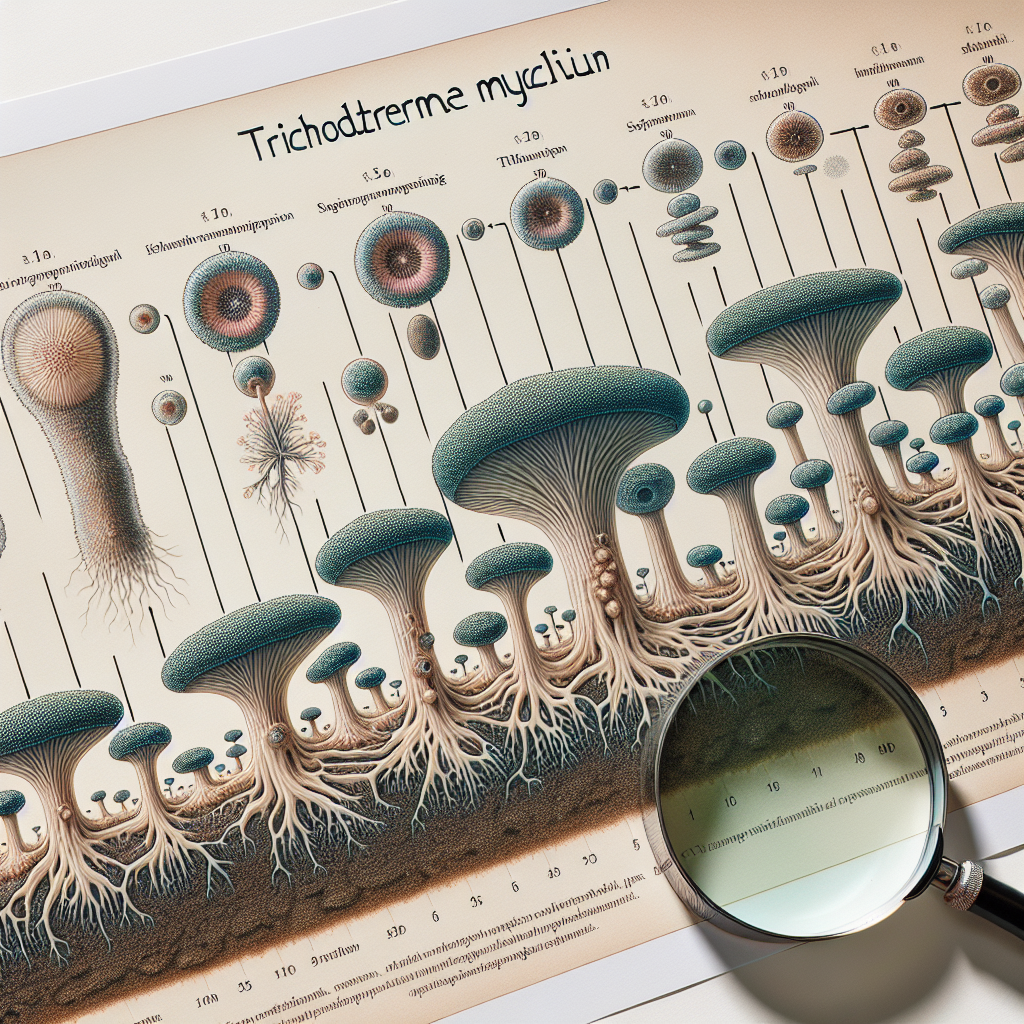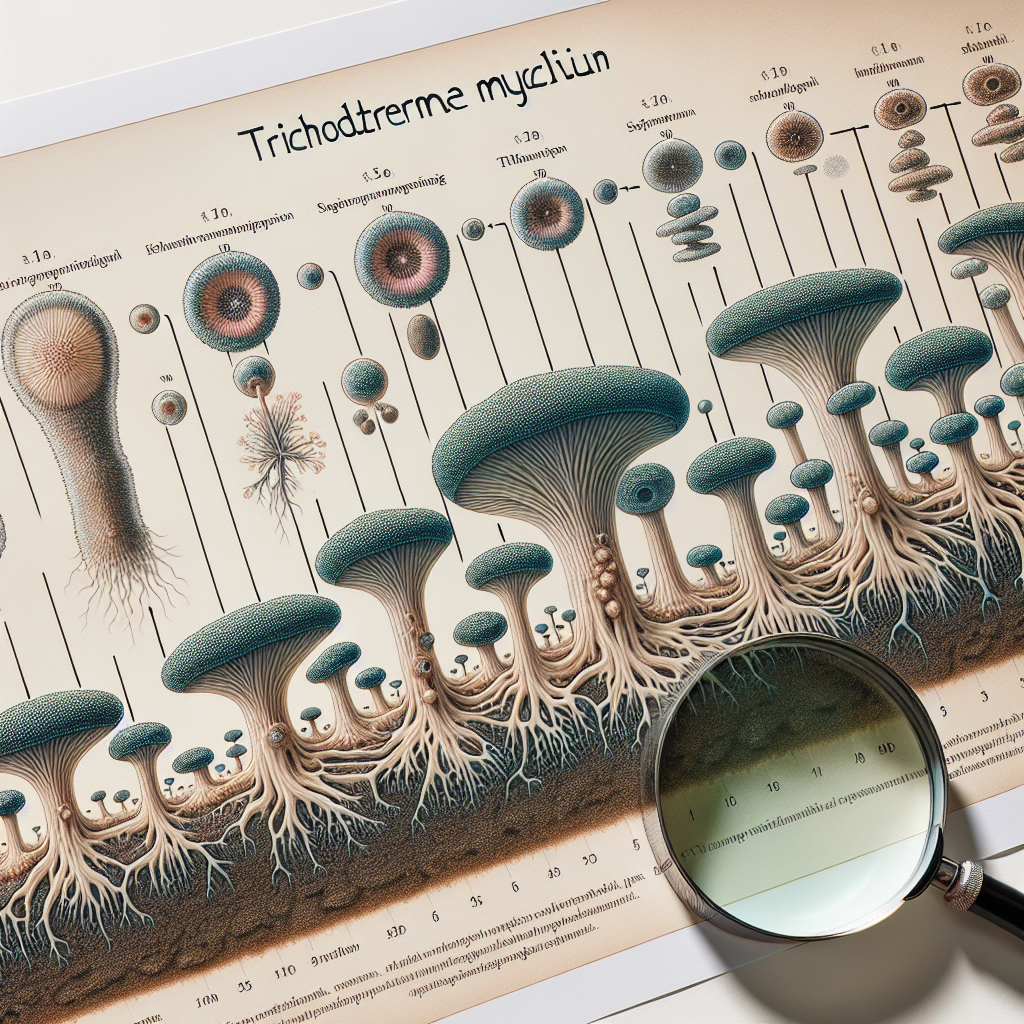In this comprehensive exploration titled “The Developmental Stages of Trichoderma Mycelium,” you’ll gain an in-depth understanding of the fascinating life cycle stages of Trichoderma Mycelium. This article presents a detailed account of this fungus species’ development, beginning from the sporulation stage progressing into the maturation phase. Through this analysis, you’ll grasp the intricacies of its growth patterns, its vital role in the decomposition of organic matter, and the implications of its presence on a broader ecological scale. Prepare yourself to embark on a journey into the microscopic world of this fungal phenom.
The Basic Biology of Trichoderma
Trichoderma is a genus of fungi that are prevalent and diverse, with a reputation for strong adaptability, pathogenic resistance, and beneficial interactions with other organisms. It’s important to fully grasp the basic biology of these fungi to comprehend their many functions and applications.
Genus Description
In the fungal kingdom Trichoderma is a genus that stands out due to its ubiquity and adaptability. It is characterized by rapid growth, spore production, and a strong competitive advantage that enables it to grow successfully in varied environments. Some species are known for their ability to inhibit the growth of other fungi through mechanisms such as mycoparasitism, making them valuable as natural biocontrol agents against numerous plant pathogens.
Habitats and Lifestyles
Trichoderma species are remarkably versatile, colonizing a wide range of habitats. You might find them in soils, wood, roots and other plant parts, as well as in agricultural compost. These fungi are facultative anaerobes, meaning they can grow in the absence of oxygen, a factor enhancing their adaptability. They can live as endophytes within plant tissues, as mutualists providing nutrients to plants, or as saprophytes decomposing organic matter in the soil, thereby contributing to nutrient cycling.
Reproductive Characteristics
The reproductive process of Trichoderma is quite multifaceted. It typically produces asexual spores known as conidia inside structures called conidiophores, but some species can also reproduce sexually. These reproductive strategies, along with their ability to form mycelium, allow for successful dispersal and colonization of new environments.
Understanding Trichoderma Mycelium
Mycelium is a network of thread-like cells known as hyphae that make up the vegetative part of a fungus. This network is crucial for fungal growth, nutrient uptake, and reproduction.
Definition of Mycelium
Mycelium is the primary fabric of fungal organisms, constituted by a network of hyphae. The main roles of mycelium are nutrient absorption, conduction, storage, and environmental interaction, thus being the primary growth and developmental component in fungi such as Trichoderma.
The Role of Mycelium in Trichoderma
The mycelium in Trichoderma has multiple roles. Its dense network of hyphae allows nutrient uptake from the environment, plays a key role in reproducing through formation of conidiophores, and helps in the colonization of new substrates. Moreover, the mycelium structure also enables Trichoderma to interact with its environment and other organisms, acting as a biocontrol agent by parasitizing other fungi’s mycelium.
Mycelium Structure in Trichoderma
In Trichoderma, the mycelium structure is intricate and versatile. It features thin, septate, and heavily branched hyphae that form a dense network. This architectural complexity serves as a survival strategy, enabling the fungus to extract nutrients efficiently and compete effectively in its environment.

The Initial Stage of Mycelium Development (Spore Germination)
The development of Trichoderma mycelium initiates from a spore. This process, known as spore germination is a crucial phase in fungal life cycle.
Spore Formation in Trichoderma
Trichoderma typically produces asexual spores called conidia. These are borne on structures known as conidiophores, which are extensions of the mycelium. The production of conidia facilitates dispersal and colonization of new habitats.
Triggers for Spore Germination
Spore germination in Trichoderma is induced by several factors including moisture, temperature, light, and the availability of suitable substrates. The spores absorb water, swell, and eventually rupture the protective coating to form a germ tube, which grows into the initial hypha.
Establishment of Initial Hyphae
The initial hyphae tun through the germination tube and extend into the substrate, forming the basis of a new mycelium network. This hyphal growth is a polarized process, meaning it occurs in specific directions dependent on the availability of nutrients and other environmental conditions.
The Growth Stage of Mycelium (Hyphal Extension)
Following spore germination, the growth stage of Trichoderma mycelium involves extensive hyphal extension and branching, driven by nutrient uptake.
Nutrient Uptake and Hyphal Extension
mycelium growth entails intensive nutrient uptake. Hyphae elongate using the energy provided by nutrients absorbed from the environment. Additionally, the hyphae secrete enzymes to break down complex molecules into simpler ones for easier absorption.
Mechanisms of Hyphae Branching
hyphae branching in Trichoderma is a crucial adaptation for optimizing nutrient foraging and colonization of substrates. This event typically occurs at the points of hyphae called septa and is largely regulated by internal (genetic, physiological) and external (environmental) cues.
Significance of Hyphal Density
The density of hyphae in the mycelium is a key determinant of the fungus’ success in exploiting resources and surviving in different environments. Higher hyphal density ensures more comprehensive exploration of the environment and greater efficiency in nutrient absorption.

The Networking Stage (Mycelial Network Formation)
Following hyphal extension and branching, the networking stage involves the integration of these hyphae into a complex mycelial network.
Communication and Coordination among Hyphae
In a mycelial network, communication and coordination among hyphae are critical for their collective functionality. Through chemical signals, hyphae can coordinate their growth directions and activities, enhancing their collective ability to exploit resources and respond to their surroundings.
Role of Mycelial Networks in Nutrient Distribution
The mycelial network serves as an efficient nutrient distribution system. Nutrients gathered by the hyphae are transported throughout the network, thereby supporting its growth and survival.
Benefits of Mycelial Networks in Ecological Interactions
Trichoderma’s mycelial networks also facilitate ecological interactions. They can establish symbiotic relationships with plants, providing nutrients in exchange for carbon. Furthermore, their biocontrol potential can help minimize plant disease by out-competing pathogenic fungi.
The Maturation Stage (Formation of Complex Structures)
The final stage in mycelium development involves the maturation and formation of complex structures like fruiting bodies, aerial hyphae, and spores.
Development of Fruiting Bodies
Fruiting bodies are multicellular structures that form on the mycelium and are responsible for spore production and dispersal. Although Trichoderma primarily reproduces asexually through conidia, some species can also form sexual fruiting bodies.
Formation of Aerial Hyphae and Spores
The development of aerial hyphae is a significant adaptation for spore dispersal. These hyphae grow upwards and form conidiophores at their tips, which produce spores to be disseminated by the air.
Role of Environmental Factors on Maturation
Factors like light, temperature, and nutrient availability can greatly influence the maturation stage. Optimal conditions promote the formation of complex structures and ensure successful propagation for Trichoderma.
Adaptations of Trichoderma Mycelium
Over time, Trichoderma mycelium has developed numerous adaptations to survive and thrive in varied environments.
Mechanisms for Stress Resistance
To survive in changing environments, Trichoderma mycelium has developed mechanisms for stress resistance. These include the production of heat-shock proteins, anti-freeze proteins, and other molecules that enhance its resilience against extreme temperatures, salinity, and drought.
Adaptations for Nutrient Acquisition
Trichoderma’s mycelium has also optimized strategies for nutrient acquisition. The secretion of enzymes to break down complex substances, the symbiotic relationship with plants, and its ability to parasitize other fungi are all adaptive traits that enhance its ability to access nutrients.
Interactions with Host Organisms
Trichoderma’s ability to interact beneficially with host organisms is a significant adaptation. As endophytes or symbiotic partners, these fungi can enhance plant growth, immunity, and resilience, conferring beneficial traits to their hosts.
The Role of Trichoderma Mycelium in Soil Health
Trichoderma mycelium plays a crucial role in maintaining soil health, by promoting good soil structure, nutrient cycling, and beneficial interactions with other microorganisms.
Effects on Soil Structure
By penetrating and weaving through soil particles, Trichoderma’s mycelium can improve soil structure, promoting water retention and aeration, factors that are critical for plant growth.
Contributions to Nutrient Cycling
Trichoderma contributes to nutrient cycling by decomposing organic matter and releasing nutrients back into the soil. Additionally, its symbiotic relationships with plants help in the transfer of nutrients, further boosting nutrient cycling.
Interactions with Other Soil Microorganisms
Trichoderma forms various interactions with other soil microorganisms. These can range from competitive interactions, where it may suppress harmful pathogens, to cooperative interactions, in which it may engage in mutualistic relationships with beneficial microbes or plants.
The Use of Trichoderma Mycelium in Agriculture
Trichoderma mycelium is highly relevant in agriculture due to its role as a biocontrol agent, a biofertilizer, and the regulatory considerations surrounding its usage.
Role in Biocontrol of Soil Pathogens
Employing Trichoderma as a biological control agent can help manage a variety of soil-borne plant pathogens. Trichoderma’s competitive growth, mycoparasitism, and the production of antifungal compounds help suppress harmful fungi, enhancing plant health and productivity.
Use as a Biofertilizer
Trichoderma’s ability to enhance nutrient uptake and improve soil structure makes it a promising biofertilizer. Additionally, its ability to form mutualistic relationships with plants can boost plant growth and crop yields.
Potential Risks and Regulations
While Trichoderma can be a powerful ally in sustainable agriculture, it’s also important to address potential risks. Its persistence and adaptability could pose environmental risks if not managed properly. Hence, the use of Trichoderma in agriculture is subject to regulations to ensure biosecurity and environmental sustainability.
Recent Research Advances in Trichoderma Mycelium
Current research on Trichoderma mycelium is providing exciting advancements in the manipulation of its genetics, ecological studies, and technologies for a deeper analysis.
Genetic Manipulations of Trichoderma Mycelium
Modern genetic tools allow the manipulation of Trichoderma at the molecular level. This results in genetically modified strains with enhanced biocontrol abilities, stress resistance, or productivity, promising improved agricultural applications.
Ecological Studies using Stable Isotope Tracing
Studying Trichoderma in its natural environment through stable isotope tracing gives insight into its ecological roles. Such research could help us understand its functionality in soil health, nutrient cycling, and plant growth promotion.
Emerging Technology for In-depth Analysis
From high-throughput DNA sequencing to advanced microscopy techniques, emerging technologies are allowing for a more in-depth understanding of Trichoderma mycelium. These tools might pave the way for novel applications and optimized use of this versatile fungus in the future.
